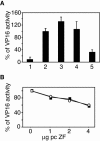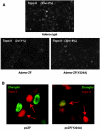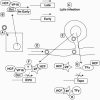The neuronal host cell factor-binding protein Zhangfei inhibits herpes simplex virus replication
- PMID: 16282471
- PMCID: PMC1287584
- DOI: 10.1128/JVI.79.23.14708-14718.2005
The neuronal host cell factor-binding protein Zhangfei inhibits herpes simplex virus replication
Abstract
During lytic infection in epithelial cells the expression of herpes simplex virus type 1 (HSV-1) immediate-early (IE) genes is initiated by a multiprotein complex comprising the virion-associated protein VP16 and two cellular proteins, host cellular factor (HCF) and Oct-1. Oct-1 directly recognizes TAATGARAT elements in promoters of IE genes. The role of HCF is not clear. HSV-1 also infects sensory neurons innervating the site of productive infection and establishes a latent infection in these cells. It is likely that some VP16 is retained by the HSV-1 nucleocapsid as it reaches the neuronal nucleus. Its activity must therefore be suppressed for successful establishment of viral latency. Recently, we discovered an HCF-binding cellular protein called Zhangfei. Zhangfei, in an HCF-dependent manner, inhibits Luman/LZIP/CREB3, another cellular HCF-binding transcription factor. Here we show that Zhangfei is selectively expressed in human neurons. When delivered to cultured cells that do not normally express the protein, Zhangfei inhibited the ability of VP16 to activate HSV-1 IE expression. The inhibition was specific for HCF-dependent transcriptional activation by VP16, since a Gal4-VP16 chimeric protein was inhibited only on a TAATGARAT-containing promoter and not a on a Gal4-containing promoter. Zhangfei associated with VP16 and inhibited formation of the VP16-HCF-Oct-1 complex on TAATGARAT motifs. Zhangfei also suppressed HSV-1-induced expression of several cellular genes including topoisomerase IIalpha, suggesting that in addition to suppressing IE expression Zhangfei may have an inhibitory effect on HSV-1 DNA replication and late gene expression.
Figures










Similar articles
-
Zhangfei: a second cellular protein interacts with herpes simplex virus accessory factor HCF in a manner similar to Luman and VP16.Nucleic Acids Res. 2000 Jun 15;28(12):2446-54. doi: 10.1093/nar/28.12.2446. Nucleic Acids Res. 2000. PMID: 10871379 Free PMC article.
-
Zhangfei is a potent and specific inhibitor of the host cell factor-binding transcription factor Luman.J Biol Chem. 2005 Apr 15;280(15):15257-66. doi: 10.1074/jbc.M500728200. Epub 2005 Feb 9. J Biol Chem. 2005. PMID: 15705566
-
Zhangfei, a novel regulator of the human nerve growth factor receptor, trkA.J Neurovirol. 2008 Oct;14(5):425-36. doi: 10.1080/13550280802275904. Epub 2008 Nov 18. J Neurovirol. 2008. PMID: 19016376
-
The herpes simplex virus VP16-induced complex: the makings of a regulatory switch.Trends Biochem Sci. 2003 Jun;28(6):294-304. doi: 10.1016/S0968-0004(03)00088-4. Trends Biochem Sci. 2003. PMID: 12826401 Review.
-
Host factors associated with either VP16 or VP16-induced complex differentially affect HSV-1 lytic infection.Rev Med Virol. 2022 Nov;32(6):e2394. doi: 10.1002/rmv.2394. Epub 2022 Sep 7. Rev Med Virol. 2022. PMID: 36069169 Free PMC article. Review.
Cited by
-
Entry of herpes simplex virus type 1 (HSV-1) into the distal axons of trigeminal neurons favors the onset of nonproductive, silent infection.PLoS Pathog. 2012;8(5):e1002679. doi: 10.1371/journal.ppat.1002679. Epub 2012 May 10. PLoS Pathog. 2012. PMID: 22589716 Free PMC article.
-
Distinct effects of glucocorticoid on pseudorabies virus infection in neuron-like and epithelial cells.J Virol. 2025 Feb 25;99(2):e0147224. doi: 10.1128/jvi.01472-24. Epub 2025 Jan 24. J Virol. 2025. PMID: 39853115 Free PMC article.
-
Control of alpha-herpesvirus IE gene expression by HCF-1 coupled chromatin modification activities.Biochim Biophys Acta. 2010 Mar-Apr;1799(3-4):257-65. doi: 10.1016/j.bbagrm.2009.08.003. Epub 2009 Aug 12. Biochim Biophys Acta. 2010. PMID: 19682612 Free PMC article. Review.
-
Molecular characterization of SMILE as a novel corepressor of nuclear receptors.Nucleic Acids Res. 2009 Jul;37(12):4100-15. doi: 10.1093/nar/gkp333. Epub 2009 May 8. Nucleic Acids Res. 2009. PMID: 19429690 Free PMC article.
-
ICP0 antagonizes ICP4-dependent silencing of the herpes simplex virus ICP0 gene.PLoS One. 2010 Jan 21;5(1):e8837. doi: 10.1371/journal.pone.0008837. PLoS One. 2010. PMID: 20098619 Free PMC article.
References
Publication types
MeSH terms
Substances
LinkOut - more resources
Full Text Sources
Molecular Biology Databases

